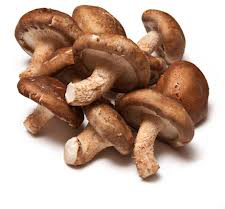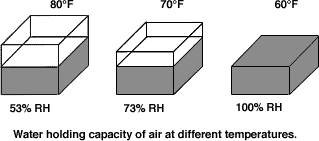Shiitake Mushrooms Growing
by Paul Przybylowicz and John Donoghue
Shiitake Growers Handbook
Effects of Humidity on Shiitake Mushrooms Growing
Evaporating of water is important during shiitake cultivation. Mushrooms consist of 85% to 95% water and are constantly losing water to the air. The substrate is also losing water. If too much water is lost, both the quantity and quality of the crop suffer. Water loss is controlled by regulating humidity levels. For this reason, the grower must understand the concept of humidity and the tools and techniques which monitor it.
Commercial Humidifiers Selection HERE

Absolute and Relative Humidity
Humidity measures the amount of water vapor in the air, usually expressed as absolute or relative humidity. Absolute humidity is the actual amount of water vapor (pounds, grams or grains) in a unit of air (cubic feet, cubic meters, pounds). The saturation point is the maximum amount of water a volume of air can hold; this increases with temperature. When the absolute humidity equals the saturation point, water begins to condense; this is referred to as the dew-point.
Commercial Humidifiers Selection HERE
Relative humidity (RH) indicates how dry or damp the air is. A practical definition of relative humidity is: the ratio of the amount of water in a unit of air (absolute humidity) to the maximum water-holding capacity of that unit of air at a given temperature (saturation point). Air at the same relative humidity will contain different amounts of water at different temperatures.
For example, a cubic foot (cu ft) of air at 80°F (27°C) contains 5.8 grains (gr) of water (7,000 grains = 1 lb). The saturation point of air at 80°F is 11.04 gr per cu ft, resulting in a relative humidity of 5.8/11.04 which equals 53% RH. If this air is cooled to 60°F (16°C) without losing any water vapor, the relative humidity would increase to 100% RH (Fig. 3-1). Thus, the dew-point would be 60°F (16°C). A one or two degree drop in temperature at high relative humidities can saturate the air, creating condensation problems on developing mushrooms.
Relative humidity is measured in several ways using an apparatus called a hygrometer. Some hygrometers use a humidity-sensitive element, often a human hair, which changes length with humidity. These hygrometers are inexpensive, work well and are accurate within 5% RH at humidities below 80%.
A more accurate type of hygrometer is the psychrometer. This tool is often used to calibrate other kinds of hygrometers. A psychrometer consists of two identical thermometers, a water reservoir and a wick around one thermometer bulb. Evaporation of water from the wick lowers the temperature of the wet bulb thermometer. The difference in temperature between the dry bulb and wet bulb is used to calculate the relative humidity. Some psychrometers can be mounted on a wall where the air circulation is sufficient, while others (sling-type) are whirled in a circle to get an accurate reading.
Commercial Humidifiers Selection HERE
Other methods of measuring relative humidity are based on cooling the air until it reaches the dew-point, then measuring changes in the electrical conductivity of humidity-sensitive materials.
Evaporation Air CapacityAs water evaporates from a surface, that surface is cooled. This phenomenon, known as evaporative cooling, is due to the latent heat of vaporization. Each molecule of water requires 540 calories to vaporize, and it obtains this energy (heat) from the surrounding environment. Thus, as the water vapor escapes, it carries a great deal of heat with it.
The rate of evaporation, evaporation potential, is determined by temperature, relative humidity and air movement. Temperature and relative humidity determine how much additional water the air can hold, whereas air movement influences the rate at which the water is removed.

For example, assume that some mushrooms are in contact with just one cubic ft of air at 55°F (13°C), 90% RH. The saturation point of air at 55°F is 4.9 gr per cu ft. Therefore, at 90% RH, the absolute humidity is 4.4 gr per cu ft. If there is no air movement or condensation, the maximum amount of water that could be lost from the mushrooms is the difference between the saturation point and the absolute humidity (i.e., 4.9 gr minus 4.4 gr = 0.5 gr).
However, if 20 cubic feet per minute (cfm) of this air were moving past the mushrooms, the evaporation potential would increase to .086 lb of water per hour (20 x 0.5 x 60 min/hr = 600 gr/hr divided by 7,000 gr/lb = .086). This translates into a loss of 2 lb of water per day into the air.
Commercial Humidifiers Selection HERE
As has been shown, evaporation potential and humidity are very important in mushroom growing. Relative humidity and air movement must be carefully controlled to avoid rapid drying, yet provide enough ventilation for good mushroom growth. The final moisture content of a mushroom depends, in part, on the humidity during maturation. Mushrooms grown at high humidities contain more water than those grown at lower humidities, given the same temperature, air flow, substrate moisture content and strain.
Post Harvest Physiology
Moisture Loss
Water loss is detrimental during storage of fresh shiitake, in part because loss of weight results in lost revenue. Mushrooms are 85% to 95% water, and there are no barriers to water loss from the mushroom surface. In fact, evaporation initially occurs at the same rate as evaporation from the surface of an open container of water.
In addition to weight loss, the quality of fresh mushrooms is lowered by water loss. Mushrooms wilt and shrivel as they lose water, thus detracting from their appearance. The degree of wilting depends on mushroom density; dense mushrooms do not wilt as readily. Mushroom density is influenced by strain and also by conditions during fruiting.
The evaporation potential of the storage facility also affects the rate of water evaporation from the mushroom surface. An additional factor is the degree of exposure of the mushrooms. Mushrooms completely exposed to the air will lose more weight than those protected by a container.
The stage of maturity also influences evaporation rate. Mature mushrooms with exposed gills have more surface area from which water can evaporate.
Temperature, relative humidity and air velocity all influence the evaporation rate. For example, Agaricus mushrooms stored for five days at 35° to 36°F (2°C), 85%-95% RH, lost 8% of their original weight. Mushrooms stored at 64°F (18°C), 40%-50% RH for the same period lost 50% of their original weight.
Commercial Humidifiers Selection HERE


Read More »
